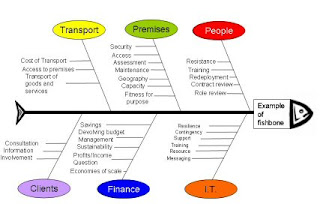05. Project Scope Statement
Project scope management includes the processes  involved in defining and controlling what is or is not included in a project. The are five main processes involved in project scope management. (referring to the table on chapter 04.)
involved in defining and controlling what is or is not included in a project. The are five main processes involved in project scope management. (referring to the table on chapter 04.)
1. Scope planning - the main output of the scope planning is the scope management plan which is a document that includes the necessary information for the team will create the project scope statement, how to create a WBS (work breakdown structure), control the deliverables and than control the closing process. As a key output of scope management plan includes a project charter which describes the high level goals for the project. It contains a title, project start and finished date as estimated, project managers information and contact, project objectives and so on until the comments about the project.
2. Project definition - the main output of project definition is creating a project scope statement. It comes after the preliminary scope statement and provides more details about the project scope. After it has been finished, than a work breakdown structure (WBS) is created.
3. Work Breakdown structure (WBS) - is a deliverable oriented grouping of the work involved in a project that defines the total scope project. An example of a WBS is given in the picture. In the WBS the project deliverables are subdivided into smaller pieces, process this known as "decomposition". WBS should be accompanied with a WBS disctionary which is a document that includes description and detailed information about each WBS item. In a WBS may work many people but the main responsibility is to only one of them.
grouping of the work involved in a project that defines the total scope project. An example of a WBS is given in the picture. In the WBS the project deliverables are subdivided into smaller pieces, process this known as "decomposition". WBS should be accompanied with a WBS disctionary which is a document that includes description and detailed information about each WBS item. In a WBS may work many people but the main responsibility is to only one of them.
4.Scope verification - involves the acceptance of the finished scope by the stakeholders. The scope statement should be submitted through a clear documentation to the stakeholders.
5.Scope Control - involves controlling changes to the project scope. Some of the tools used to implement scope control includes; a change control system, performing variance analysis and so on. Variance is the difference between planned and actual performance.
 involved in defining and controlling what is or is not included in a project. The are five main processes involved in project scope management. (referring to the table on chapter 04.)
involved in defining and controlling what is or is not included in a project. The are five main processes involved in project scope management. (referring to the table on chapter 04.) 1. Scope planning - the main output of the scope planning is the scope management plan which is a document that includes the necessary information for the team will create the project scope statement, how to create a WBS (work breakdown structure), control the deliverables and than control the closing process. As a key output of scope management plan includes a project charter which describes the high level goals for the project. It contains a title, project start and finished date as estimated, project managers information and contact, project objectives and so on until the comments about the project.
2. Project definition - the main output of project definition is creating a project scope statement. It comes after the preliminary scope statement and provides more details about the project scope. After it has been finished, than a work breakdown structure (WBS) is created.
3. Work Breakdown structure (WBS) - is a deliverable oriented
 grouping of the work involved in a project that defines the total scope project. An example of a WBS is given in the picture. In the WBS the project deliverables are subdivided into smaller pieces, process this known as "decomposition". WBS should be accompanied with a WBS disctionary which is a document that includes description and detailed information about each WBS item. In a WBS may work many people but the main responsibility is to only one of them.
grouping of the work involved in a project that defines the total scope project. An example of a WBS is given in the picture. In the WBS the project deliverables are subdivided into smaller pieces, process this known as "decomposition". WBS should be accompanied with a WBS disctionary which is a document that includes description and detailed information about each WBS item. In a WBS may work many people but the main responsibility is to only one of them. 4.Scope verification - involves the acceptance of the finished scope by the stakeholders. The scope statement should be submitted through a clear documentation to the stakeholders.
5.Scope Control - involves controlling changes to the project scope. Some of the tools used to implement scope control includes; a change control system, performing variance analysis and so on. Variance is the difference between planned and actual performance.



Comments